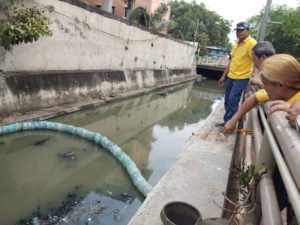
A biofence was installed at a stream along Barangay Tinago and Barangay San Roque in Cebu City which will serve to prevent garbage from flowing into the open sea.
PhotoS / Nida Cabrera, CENRO Head
Not only did the seas become clean, the lives of some of our residents became clean as well.
A huge amount of garbage used to float on the waters surrounding the fishports of Pasil, Suba, and Sawang Kalero, and the river in Tejero.
Unquantifiable though the trash were, all flowed into the sea wreaking havoc on Cebu’s marine resources until the Cebu City Environment and Natural Resources Office (Ccenro) stepped in.
Ccenro launched a biofence project that would begin to change the state of Cebu City’s seas.
The biofence is a 10-meter floating fence made of over 400 recycled plastic bottles held together by a fishnet.
It serves to block garbage from the upstreams flowing into the seas.
Just one month after the installation of the first batch of biofences, people began to see the changes they brought.
Nita Lagunda, 43, a fish vendor at the Pasil public market, said that she was used to seeing her 11-year-old son, Kiko, jump off the port to swim in the sea.
But she later discouraged Kiko from taking a dip in the waters because the seas surrounding the fishport had become so filthy she was afraid her son would be sick.
“Karon, pasagdan na nako mokuyog-kuyog anang manguha sa basura sa biofence kay nakita na ko murag limpyo na man ang dagat. Naa nay kausaban makita (Now, I allow him to go with those assigned to take out the garbage from the biofence because I see that the sea is cleaner. I can see the change.),” said Lagunda who believed that it was now safe for her son to swim in the waters surrounding the fish port.
Sawang Kalero Barangay Captain Sergio Ocaña, agreed with Lagunda saying that the biofences were a jumpstart for change.
“Dako kaayong tabang kini nga proyekto. Makalipay nga makakita nga dili na murag kanal atong dagat (This project is a big help. I am happy to see that our seas no longer look like canals.),” said Ocana.
Ocaña did not only notice a difference in the sea; but also changes in some of his barangay constituents.
For Sawang Calero, Ocaña commissioned 20 jobless residents, who work in shifts per week, to maintain the biofences.
“Dili lang kay nalimpyo ang dagat, nalimpyo sad ang kinabuhi sa ubang lumulupyo nato dinhi. (Not only did the seas become clean, the lives of some of our residents became clean as well),” said Ocaña.
Some of the people commissioned by Ocana to maintain the biofences were not only jobless but also suffered from vices.
Their new job of maintaining the biofences, he said, gave an opportunity for these people to not only survive but to also find meaning in life.
The biofence collects an average of 4.6 tons of garbage per week and people are needed to collect the trash daily.
In order to keep the project sustainable, Ccenro partnered with the barangays to maintain the fences.
The barangays are responsible for commissioning people to collect the garbage.
Ccenro head, Nida Cabrera said that aside from solving the garbage problem, the goal of the biofence is to encourage residents to take an active role in the development of their community.
On its first month, the biofence has been successful in collecting over 26 tons of garbage.
“When it comes to its performance and usefulness to clean our coastal areas and rivers, I think it’s a big success. We hope to implement this in all barangays,” Cabrera said.
Ccenro has received requests from other barangays to install biofences in their areas.
Cabrera was hopeful that barangays will not only install one biofence but will have biofences for every river, stream, and port in the village.
She expressed happiness for how the biofence not only changed the face of the waters but also the quality of people’s lives.
“I hope that the biofences will continue to serve its purpose to the environment and to our people,” she said.